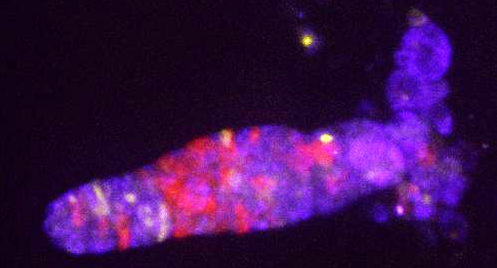
Dictyostelium discoideum in a multicellular state. Misfolding-prone proteins are indicated in yellow.
When the „Ice Bucket Challenge“ became viral, it helped to promote awareness of the disease amyotrophic lateral sclerosis (ALS). Like Alzheimer’s or Huntington, the disease ALS is triggered by misfolded proteins that cause the death of neurons. These proteins have a high aggregation potential, meaning they tend to misfold and aggregate more than others. This is often the case when their sequence shows a high concentration of the amino acids glutamine and asparagine. Such proteins have been shown to cause age-related neurodegenerative diseases.
Researchers at the Max Planck Institute of Molecular Cell Biology and Genetics (MPI-CBG) now studied the slime mold Dictyostelium discoideum. They found that this organism contains the highest amount of misfolding-prone proteins of all organisms investigated to date. While this would lead to cytotoxic aggregation in other organisms, the researchers found that Dicty has undergone specific adaptations of the control machinery that prevent protein aggregation. As a consequence, the disease-related proteins are innocuous to Dicty. However, when exposed to stress, the control system of Dicty fails, and proteins start to misfold and aggregate. Key components of the control system that Dicty uses are molecular chaperones – proteins that refold misfolded proteins. Further studies will uncover the molecular adaptations that have equipped Dictyostelium discoideum with a more robust control system. (PNAS, 4 May 2015)
Cellular functionality depends on a delicately balanced system that synthesizes, folds, and degrades proteins. Even subtle changes of this system can cause imbalances and significantly affect cellular health – or even cause cell death. There are proteins that have a higher tendency to misfold and form aggregates than other proteins, and these proteins often cause age-related diseases. These disease-associated proteins often have a high amount of the amino acids glutamine and asparagine and can become very harmful and dangerous – essentially in all organisms studied to date. However, Dictyostelium discoideum, the organims with the highest content of these proteins, seems to have developed mechanisms to keep them under control. In Dicty, misfolding-prone proteins remain folded and innocuous. Simon Alberti, research group leader at the MPI-CBG, and his team looked deeper into these mechanisms that help Dicty to efficiently regulate these dangerous proteins.
Dicty’s strategy
„Proteins with a high risk to misfold are kept under tight surveillance by molecular chaperones“, says postdoc Liliana Malinovska. She studied how these chaperones avoid proteins from forming dangerous aggregates in Dicty. The Dresden research team also showed that in Dicty, proteins that tend to form aggregates accumulate in the nucleus and are degraded there. „These seem to be Dicty’s strategies to respond to the high concentration of proteins that are very likely to misfold and become problematic“, says Malinovska.
Further studies will reveal the specific molecular adaptations that allow for a more efficient control of proteins with a higher misfolding tendency in Dicty. This could point to new therapeutic interventions to treat the many protein-misfolding diseases that manifest with increasing age.
Liliana Malinovska, Sandra Palm, Kimberley Gibson, Jean-Marc Verbavatz and Simon Alberti:
Dictyostelium discoideum has a highly Q/N-rich proteome and shows an unusual resilience to protein aggregation
PNAS Early Edition, 4 May 2015
doi: 10.1073/pnas.1504459112